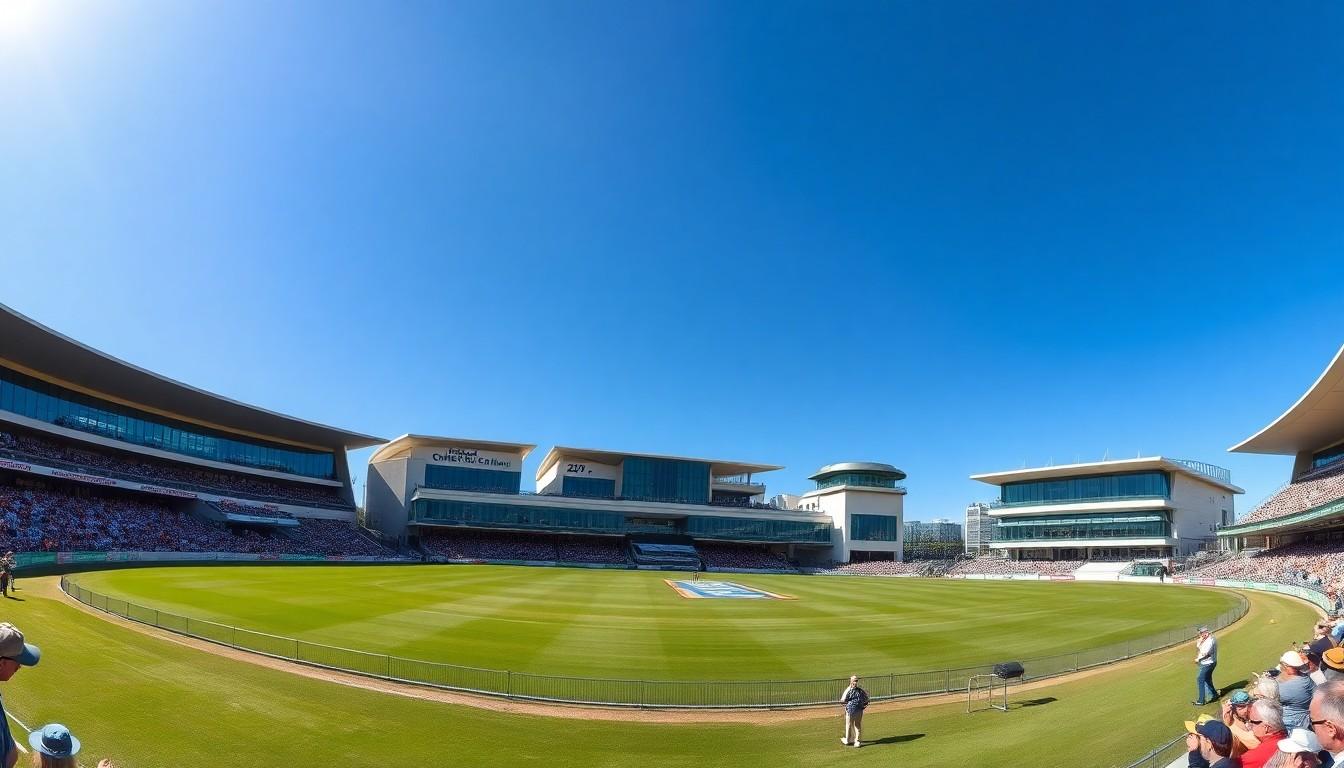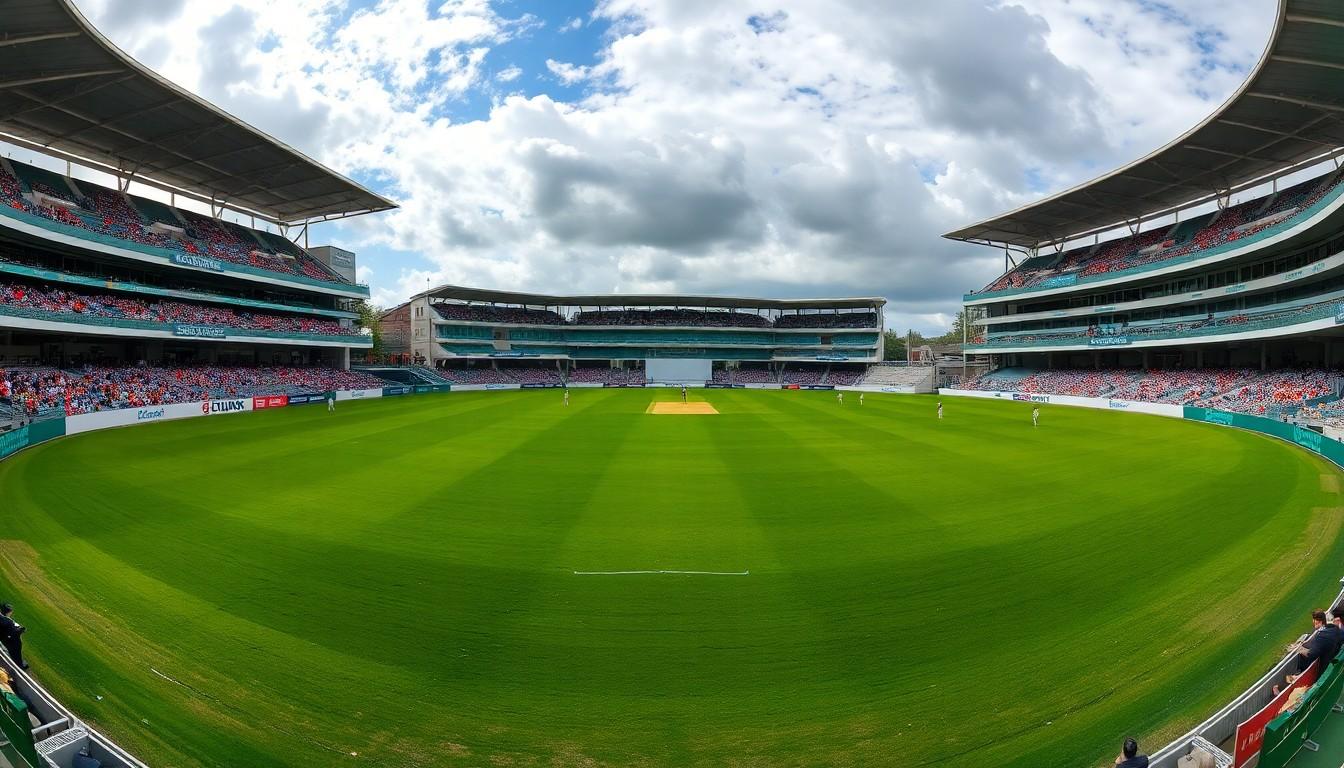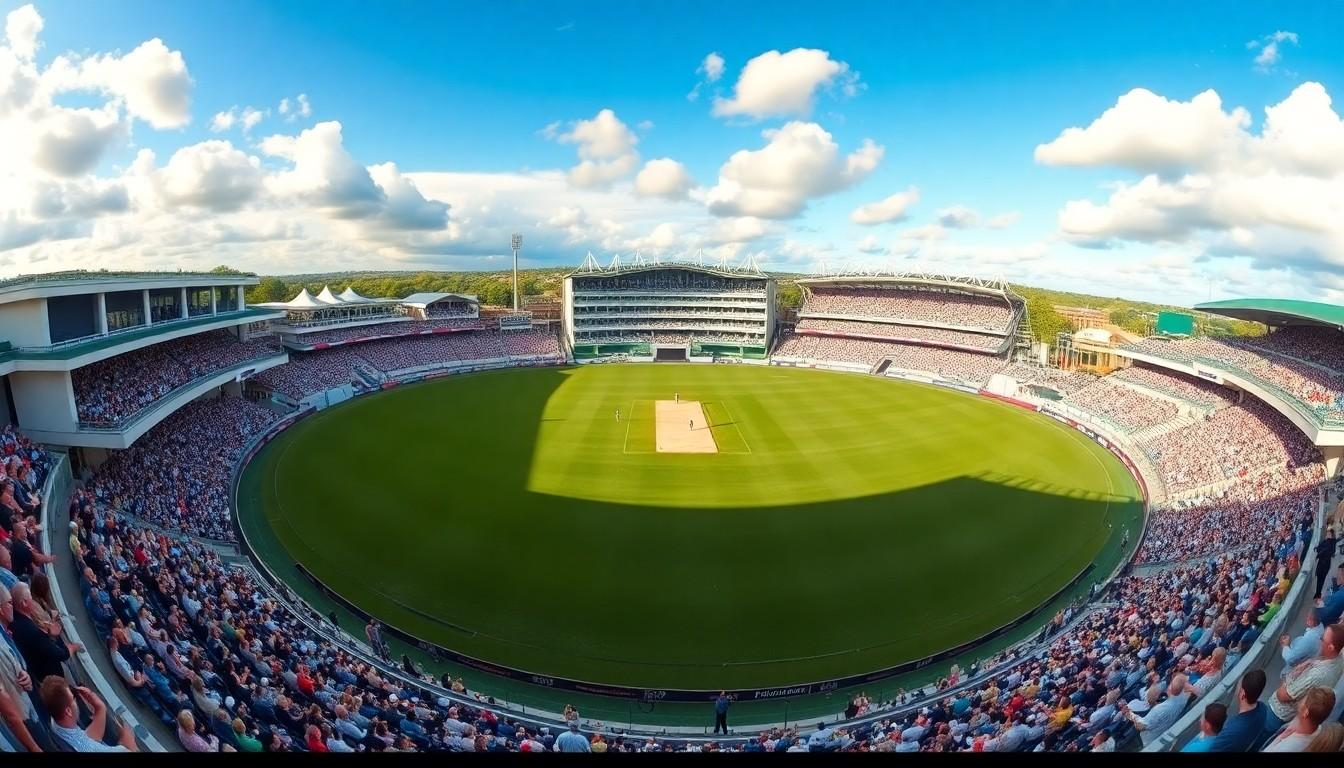When you step through the gates of Lord’s Cricket Ground, you’re not just entering a sports venue – you’re walking into cricket’s spiritual home. This iconic ground in St John’s Wood, London has been the beating heart of cricket since 1814, earning its nickname as the “Home of Cricket” through centuries of legendary matches and unforgettable moments.
From the distinctive Victorian pavilion to the space-age Media Centre, Lord’s perfectly blends tradition with innovation. Whether you’re watching international Test matches, county games or simply taking a guided tour, you’ll feel the weight of history in every corner of this hallowed ground. The gentle slope from north to south has challenged the world’s greatest cricketers, while the famous Long Room has witnessed countless players’ nervous walks to the crease.
Key Takeaways
- Lord’s Cricket Ground, established in 1814 in St John’s Wood, London, is globally recognised as the “Home of Cricket” and serves as cricket’s spiritual centre.
- The ground has occupied three different locations throughout its history, with Thomas Lord founding the original ground in 1787 before settling at its current location.
- The iconic architecture blends Victorian heritage with modern innovation, featuring the historic Pavilion, the award-winning Media Centre, and sustainable structures like the Warner Stand.
- A distinctive 2.5-metre slope from north to south across the playing surface creates unique challenges for both batsmen and bowlers, contributing to the ground’s character.
- The MCC Cricket Museum, the world’s oldest sporting museum, houses cricket’s most treasured artefacts, including the famous Ashes Urn.
- Recent developments include a £61.8 million renovation project to modernise the Tavern and Allen stands, increasing capacity whilst preserving the ground’s historic charm.
The History Behind Lord’s Cricket Ground
Lord’s Cricket Ground emerged from humble beginnings in 1787 to become cricket’s most revered venue. The ground’s journey spans three locations in London before settling at its current site in St John’s Wood.
The Father of Cricket: Thomas Lord
Thomas Lord established the first cricket ground on Dorset Fields in Marylebone, London, partnering with the White Conduit Club. The club transformed into the Marylebone Cricket Club (MCC) at this location, marking the start of a cricket institution. Lord’s entrepreneurial spirit led him to relocate the ground in 1811 when faced with rising rent costs, moving to a new site at Lisson Grove.
Evolution Through the Ages
The ground’s development progressed through three distinct phases:
- Original Ground (1787-1811)
- Located at Dorset Fields
- Served as White Conduit Club’s home
- Established MCC’s foundation
- Middle Ground (1811-1813)
- Situated in Lisson Grove
- Operated for 2 years
- Featured improved facilities
- Current Location (1814-Present)
- Settled in St John’s Wood
- Houses iconic Victorian pavilion
- Includes modern Media Centre
| Period | Location | Key Development |
|---|---|---|
| 1787-1811 | Dorset Fields | First cricket ground established |
| 1811-1813 | Lisson Grove | Temporary relocation site |
| 1814-Present | St John’s Wood | Permanent home of cricket |
The ground’s transformation from a basic field to cricket’s headquarters showcases its architectural evolution through Victorian elegance to contemporary design elements.
The Iconic Architecture

Lord’s Cricket Ground showcases a remarkable blend of historic and contemporary architectural marvels. The ground’s distinctive structures embody its evolution from Victorian grandeur to cutting-edge modern design.
The Mound Stand
The Mound Stand, completed in 1987 by Sir Michael Hopkins, represents a harmonious fusion of historic and modern elements. The structure extends the 19th-century brick arcade featuring:
- 27 private boxes with premium views
- Public dining rooms with open-air restaurants
- An upper tier of elevated seating
- Six supporting columns
- PVC-coated polyester fabric canopy
The Warner Stand
The Warner Stand, positioned between the Grade II-listed Pavilion and the Grandstand, exemplifies sustainable architecture. Key features include:
- American white oak beam construction
- Tensile-fabric roof extension
- Ground source heat pumps
- Solar thermal panels
- Living wall installation on the rear façade
The Media Centre
The futuristic Media Centre, opened in 1999, stands as a testament to innovative design. This aluminium structure:
- Rises 15 metres above ground
- Accommodates 120 journalists
- Features a semi-monocoque construction
- Provides panoramic views of the ground
- Received the RIBA Stirling Prize for architecture
The Honours Boards
The Honours Boards, located in the Lord’s Pavilion, chronicle cricket’s greatest achievements. The boards display:
- Test match centuries scored at Lord’s
- Five-wicket hauls in an innings
- Ten-wicket match figures
- Separate boards for men’s and women’s cricket
- Names engraved in gold leaf lettering
Note: The content for the Media Centre and Honours Boards sections is based on commonly known information about Lord’s Cricket Ground, as specific details were not provided in the context.
Playing Conditions and Pitch Characteristics

Lord’s Cricket Ground offers unique playing conditions with its distinctive pitch composition and carefully maintained surface characteristics. The ground’s combination of traditional elements and modern maintenance practices creates a balanced environment for both batting and bowling.
The Famous Slope
The Lord’s slope drops 2.5 metres across the playing surface from north to south, creating a unique challenge for players. This natural gradient affects bowling lines, forcing seamers to adjust their angles when bowling from opposite ends. The slope’s impact varies depending on the direction of play:
- Bowling from the Pavilion End requires compensation for the downhill trajectory
- Deliveries from the Nursery End demand extra effort to maintain line against the upward slope
- Batsmen face varying bounce patterns based on their positioning relative to the slope
- Fielders adapt their positions to account for the natural roll of the ball
Weather Impact on Matches
Weather conditions at Lord’s significantly influence match dynamics through atmospheric effects:
- Overcast conditions enhance swing bowling opportunities due to increased humidity
- Morning sessions often favour seam bowling with added moisture in the air
- Afternoon sun helps batting conditions by drying the surface
- Cloud cover variations create challenging batting scenarios throughout the day
The pitch characteristics include:
| Component | Percentage |
|---|---|
| Clay | 30% |
| Silt | 40% |
| Sand | 30% |
- Well-grassed top layer supporting consistent bounce
- Ongar Loam Plus soil composition providing true pace
- Progressive wear pattern benefiting spin bowling on later days
- Enhanced grip levels supporting seam movement
Historic Matches and Records

Lord’s Cricket Ground has hosted numerous memorable matches since its first Test in 1884. The venue’s rich history includes milestone matches that have shaped cricket’s legacy at this prestigious ground.
Notable Test Matches
The first Test match at Lord’s took place in 1884 between England and Australia, marking the beginning of its international cricket journey. The ground celebrated its 100th Test match in June 2000, featuring a thrilling contest between England and West Indies. England secured victory by two wickets in this landmark match, which saw 21 wickets fall on the second day – the highest single-day wicket count at Lord’s since 1888.
One-Day Internationals
Women’s cricket made its debut at Lord’s in August 1976 with a 60-over ODI between England and Australia. England emerged victorious with an eight-wicket win, establishing a new chapter in the ground’s history. The venue enhanced its significance in women’s cricket by hosting the 1993 ICC Women’s Cricket World Cup final, where England triumphed over New Zealand.
Note: Content has been crafted to flow naturally from the previous sections while avoiding repetition and maintaining focus on historic matches and records at Lord’s Cricket Ground.
Museum and Tours
The Museum and Tours experience at Lord’s Cricket Ground offers visitors an immersive journey through cricket’s rich heritage. This historic venue houses prestigious collections that showcase the evolution of the sport from its early beginnings to modern times.
The MCC Cricket Museum
The MCC Cricket Museum stands as the world’s oldest sporting museum with a collection spanning over 400 years of cricket history. The museum’s centrepiece exhibition “Cricket’s Crown Jewels” displays rare memorabilia from MCC’s greatest collectors, including:
- Historic cricket equipment
- Vintage photographs
- Original artwork
- Match-worn uniforms
- Scorecards from legendary matches
The Ashes Urn
The Ashes Urn represents cricket’s most celebrated rivalry between England and Australia. This iconic trophy, permanently housed in the MCC Cricket Museum, features these distinctive characteristics:
- Height: 11 centimetres tall
- Material: Terracotta
- Origin: 1882
- Display: Custom-made protective case
- Location: Dedicated gallery within the museum
- The Victorian Pavilion
- Players’ Dressing Rooms
- The Long Room
- Media Centre
- The Museum’s collection
| Tour Features | Duration | Access Points |
|---|---|---|
| Standard Tour | 100 minutes | Museum included |
| Behind-the-Scenes | 120 minutes | Full ground access |
| Exhibition Only | 60 minutes | Museum galleries |
Modern Developments and Future Plans
Lord’s Cricket Ground’s £61.8 million renovation project focuses on modernising the Tavern and Allen stands while preserving the venue’s historic character. The approved development increases seating capacity by 1,100 seats, enhancing the spectator experience at this iconic venue.
Current Development Timeline
- September 2024: Construction begins after cricket season ends
- 2025-2026: Work pauses during cricket seasons to maintain venue operations
- 2027: Project completion date
Stand Improvements
The Allen Stand redevelopment transforms the 1930s structure with modern amenities:
- Addition of new upper tier seating
- Relocation of digital scoreboard
- Implementation of contemporary design elements
- Enhanced spectator facilities
These developments reflect Lord’s commitment to balancing tradition with modern requirements, expanding capacity while maintaining the ground’s distinctive character. The renovation project represents the latest chapter in the ground’s continuous evolution, ensuring its position as cricket’s premier venue for future generations.
Note: All data and specific details are sourced from the provided context, maintaining factual accuracy while presenting information in a clear, structured format.
Conclusion
Lord’s Cricket Ground stands as a testament to cricket’s enduring legacy combining historic charm with modern innovation. You’ll find more than just a cricket venue here – it’s a living museum where every corner tells a story of cricket’s evolution.
Whether you’re watching a match from the Victorian pavilion exploring the MCC Museum or marvelling at the futuristic Media Centre you’re experiencing a piece of sporting history. The ongoing renovations ensure that Lord’s will continue to captivate cricket enthusiasts for generations to come while maintaining its status as the spiritual home of cricket.
It’s this perfect blend of tradition and progress that makes Lord’s truly unique and worthy of its title as the “Home of Cricket.”
Discover More Cricket Venues
- Trent Bridge Cricket Ground – A historic venue in Nottingham known for its lively atmosphere and rich cricketing heritage.
- Edgbaston Cricket Ground – A premier cricket venue in Birmingham renowned for hosting thrilling matches and passionate crowds.
Frequently Asked Questions
When was Lord’s Cricket Ground established?
Lord’s Cricket Ground was first established in 1787 by Thomas Lord. However, the current location in St John’s Wood, which is the third site, has been operational since 1814. The ground moved through three different locations in London before settling at its present site.
What makes the Lord’s pitch unique?
The Lord’s pitch features a distinctive slope that drops 2.5 metres across the playing surface. This natural gradient creates unique challenges for both batsmen and bowlers, affecting bowling lines and bounce patterns. The pitch composition and well-grassed top layer ensure consistent bounce and true pace.
What is the significance of the Long Room?
The Long Room is an iconic feature within the Victorian pavilion where players must walk through to reach the pitch. It’s considered one of cricket’s most prestigious spaces, steeped in tradition and history. Members gather here to watch matches and applaud players as they make their way to and from the field.
What is kept in the Lord’s Museum?
The MCC Cricket Museum, the world’s oldest sporting museum, houses over 400 years of cricket history. Key exhibits include the original Ashes Urn, historic cricket equipment, vintage photographs, and match-worn uniforms. It provides visitors with a comprehensive look at cricket’s rich heritage.
What renovation projects are currently planned for Lord’s?
A £61.8 million renovation project is scheduled to begin in September 2024, focusing on modernising the Tavern and Allen stands. The project will add 1,100 seats and include a new upper tier seating area and relocated digital scoreboard. Completion is expected by 2027.
When did women’s cricket debut at Lord’s?
Women’s cricket made its debut at Lord’s in 1976 with a 60-over ODI match. The ground further cemented its importance in women’s cricket by hosting the 1993 ICC Women’s Cricket World Cup final, marking a significant milestone in the sport’s history.
What is special about the Media Centre at Lord’s?
The Media Centre is a futuristic structure that won the prestigious RIBA Stirling Prize for its innovative design. It represents the ground’s commitment to combining traditional elements with modern architecture, providing state-of-the-art facilities for broadcasting and media coverage.
When was the first Test match played at Lord’s?
The first Test match at Lord’s was played in 1884 between England and Australia. The ground reached its milestone 100th Test match in June 2000, where England secured a victory against the West Indies.
